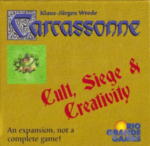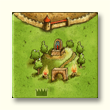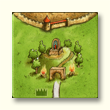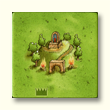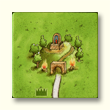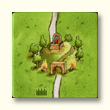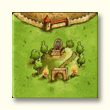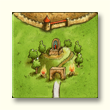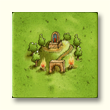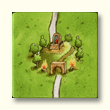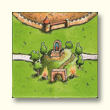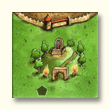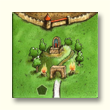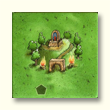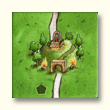Kacíři a kultovní místa (původní edice)
 |
Na této stránce najdete pravidla pro takto ilustrované kartičky. |
 | Pokud se vaše kartičky podobají těmto, přejděte na tato pravidla: |
| Pokud grafika na vašich kartičkách vypadá úplně jinak, bude mít jinou spin-off hru Carcassonne. |  |
Úvod
 |
| WICA symbol rozšíření |
Česká pravidla k rozšíření ![]() Kacíři a kultovní místa ilustrovaném ve stylu původní edice (C1), vycházejí na této stránce z oficiální předlohy. Nejnovější pravidla publikovalo roku 2007 jako součást samostatného rozšíření. Na této stránce je uveden jejich přepis s korekčními úpravami popsanými na souhrnné stránce:
Kacíři a kultovní místa ilustrovaném ve stylu původní edice (C1), vycházejí na této stránce z oficiální předlohy. Nejnovější pravidla publikovalo roku 2007 jako součást samostatného rozšíření. Na této stránce je uveden jejich přepis s korekčními úpravami popsanými na souhrnné stránce: ![]() Poznámky k českému překladu.
Poznámky k českému překladu.
Herní materiál
- 5 nových kartiček krajiny (Král, hrabě a řeka): se symbolem koruny
- 6 nových kartiček krajiny (Kultovní místa, obléhání a tvořivost): bez symbolu
- 5 nových kartiček krajiny (Spielbox): se symbolem pětiúhelníku
Pravidla
Příprava hry
The new land tiles should be mixed in with the other tiles. This expansion has been developed for the Carcassonne basic game.
Přiložení kartičky
Shrines are placed and scored in the same way as a cloister. [1] However, a shrine may not be placed in such a way that it adjoins several cloisters. [2] Similarly, a cloister may not be placed so that it neighbors several shrines. [3] [4] [5]
Deploying a follower
A follower deployed to a shrine is called a heretic. If a player places a shrine directly (horizontally, vertically, or diagonally) next to the cloister [6] of another player [7] and deploys a heretic to it, a challenge is laid down to the monk. [8] The same is true when a monk is deployed to a cloister directly next to a heretic. [9] Challenging your own monk or heretic is also possible. [10] [11] [12]
When a player places a shrine tile, he or she may, as usual, choose to deploy a follower to the farm, road, or city segment of the tile, instead of to the shrine itself. [13]
Scoring
When you complete one or more features (e.g. a monastery, a road etc.) by placing a Shrine land tile, it is scored according to the normal rules.
The challenge
The challenge is about who can finish his or her building first. [14] [15]
The player who finishes his or her feature first scores 9 points, [16] while the other player scores nothing. [17] [18] [19] Both followers are then returned to their owners. [20] [21]
Závěrečné vyhodnocení
If a challenge has not been resolved by the end of the game, both players receive the usual points awarded for incomplete cloisters.
Domácí pravidla
- To raise the stakes of a challenge between shrines and cloisters, and to make it more worthwhile to risk the chance of getting no points, the winning challenger receives the points for both structures while the loser still receives nothing. If promoting more aggressive play, the challenger could be the only one playing for the reward. (Thanks to youtch and others; thanks to RationalLemming, and to avt104981 for pointing out that this can’t result in 18 points)
Seznam kartiček
Král, hrabě a řeka varianta
 - označuje kartičky s novou ilustrací tohoto rozšíření:
- označuje kartičky s novou ilustrací tohoto rozšíření:  | kultovní místo
| kultovní místo
Kultovní místa, obléhání a tvořivost varianta
 - označuje kartičky s novou ilustrací tohoto rozšíření:
- označuje kartičky s novou ilustrací tohoto rozšíření:  | kultovní místo
| kultovní místo
Spielbox varianta
 - označuje kartičky s novou ilustrací tohoto rozšíření:
- označuje kartičky s novou ilustrací tohoto rozšíření:  | kultovní místo
| kultovní místo
Poznámky pod čarou
Vysvětlení ikonek najdete na této stránce.
- ↑
 A knight in a besieged city from
A knight in a besieged city from  Kataři can escape via a shrine, as with a cloister. The shrines are, for the most part, identical to cloisters. That goes for escape as well.
Kataři can escape via a shrine, as with a cloister. The shrines are, for the most part, identical to cloisters. That goes for escape as well.
- ↑
 In other words, a shrine cannot adjoin more than one cloister, and vice versa.
In other words, a shrine cannot adjoin more than one cloister, and vice versa.
- ↑
 Question: Can I place a shrine in such a way that it forces a cloister to neighbor several shrines? What effect does that have? Answer: It leads to enormous problems when multiple cloisters and shrines neighbor each other. [In other words, no, you can’t place a shrine in that way—ed.]
Question: Can I place a shrine in such a way that it forces a cloister to neighbor several shrines? What effect does that have? Answer: It leads to enormous problems when multiple cloisters and shrines neighbor each other. [In other words, no, you can’t place a shrine in that way—ed.]
- ↑
 The rules that restrict the placement of cloisters next to already placed shrines also restrict the placement of abbeys.
The rules that restrict the placement of cloisters next to already placed shrines also restrict the placement of abbeys.
- ↑
 Because the problems arise when there are multiple simultaneous challenges, one could allow placement of further shrines or cloisters into the area as long as no followers are placed on those cloisters/shrines (i.e. there are no further challenges).
Because the problems arise when there are multiple simultaneous challenges, one could allow placement of further shrines or cloisters into the area as long as no followers are placed on those cloisters/shrines (i.e. there are no further challenges).
- ↑
 A shrine can challenge an abbey, and vice versa, because the abbey is also a cloister.
A shrine can challenge an abbey, and vice versa, because the abbey is also a cloister.
- ↑
 The RGG edition of Count, King & Robber changes this to “When a heretic is placed on a shrine adjacent (orthogonally or diagonally) to an occupied monastery, a challenge occurs.” Because the part about “another player,” was removed, the final sentence in this paragraph regarding one’s own monk/heretic became unnecessary and was also removed. (12/2013)
The RGG edition of Count, King & Robber changes this to “When a heretic is placed on a shrine adjacent (orthogonally or diagonally) to an occupied monastery, a challenge occurs.” Because the part about “another player,” was removed, the final sentence in this paragraph regarding one’s own monk/heretic became unnecessary and was also removed. (12/2013)
- ↑
 When playing with Německý klášter, Holandsko-belgický klášter, an abbot cannot be involved in a challenge with a heretic on a shrine/cult place, as the two scoring mechanisms are entirely different (the abbot’s monastery is never completed, so the heretic would always win). (5/2014)
When playing with Německý klášter, Holandsko-belgický klášter, an abbot cannot be involved in a challenge with a heretic on a shrine/cult place, as the two scoring mechanisms are entirely different (the abbot’s monastery is never completed, so the heretic would always win). (5/2014)
- ↑
 The RGG edition of
The RGG edition of  Big Box 2 adds, ‘That is, the monk must challenge the heretic.’
Big Box 2 adds, ‘That is, the monk must challenge the heretic.’
- ↑
 This sentence is omitted in the RGG version.
This sentence is omitted in the RGG version.
- ↑
 A magic portal also allows you to trigger a challenge on shrines, as these are areas of the landscape and tiles that were placed by the players during the game and on which a follower could also have been placed normally.
A magic portal also allows you to trigger a challenge on shrines, as these are areas of the landscape and tiles that were placed by the players during the game and on which a follower could also have been placed normally.
- ↑
 The fairy can be assigned to a heretic.
The fairy can be assigned to a heretic.
- ↑
 The RGG version adds that a player may also “choose to place no follower at all on the tile.”
The RGG version adds that a player may also “choose to place no follower at all on the tile.”
- ↑
 If the tile placed completes both the shrine and the cloister, no one completed the building first, and both receive the points.
If the tile placed completes both the shrine and the cloister, no one completed the building first, and both receive the points.
- ↑
 Question: Imagine I have an unoccupied cloister next to an occupied shrine. I place a tile with a magic portal which completes both buildings, and choose to use the magic portal to deploy a monk to the cloister. Does this declare a challenge, and if so, who wins? Answer: This is actually an invalid placement of the follower – the magic portal cannot be used to place a follower on a completed feature (and the cloister is considered completed before the move wood phase). Thus, there can be no challenge, and the heretic gets 9 points. (updated 7/2014)
Question: Imagine I have an unoccupied cloister next to an occupied shrine. I place a tile with a magic portal which completes both buildings, and choose to use the magic portal to deploy a monk to the cloister. Does this declare a challenge, and if so, who wins? Answer: This is actually an invalid placement of the follower – the magic portal cannot be used to place a follower on a completed feature (and the cloister is considered completed before the move wood phase). Thus, there can be no challenge, and the heretic gets 9 points. (updated 7/2014)
- ↑
 The RGG edition adds a clarification here: “Once a challenge has been declared, the player (of those two involved in the challenge) who first completes his cult place or cloister scores 9 points as normal.”
The RGG edition adds a clarification here: “Once a challenge has been declared, the player (of those two involved in the challenge) who first completes his cult place or cloister scores 9 points as normal.”
- ↑
 Question: If the fairy is on the same tile as the losing heretic or monk in a challenge, does the player still score the bonus 3 points? Answer: When a challenge is resolved (that is, when someone has won), both followers are returned to the player, so no one stands next to the fairy. [At the point that a challenge is resolved and one participant “scores” zero, the building that participant is in will be incomplete. Therefore, strictly speaking, that participant does not actually take part in “scoring”—say, in the way that a player without the majority in a city does—and so does not score the bonus points —ed.]
Question: If the fairy is on the same tile as the losing heretic or monk in a challenge, does the player still score the bonus 3 points? Answer: When a challenge is resolved (that is, when someone has won), both followers are returned to the player, so no one stands next to the fairy. [At the point that a challenge is resolved and one participant “scores” zero, the building that participant is in will be incomplete. Therefore, strictly speaking, that participant does not actually take part in “scoring”—say, in the way that a player without the majority in a city does—and so does not score the bonus points —ed.]
- ↑
 Question: Say I have a heretic engaged in a challenge with another player's monk, and I place the tile which completes the monk's cloister, so that the monk scores 9 points and I score 0. Can I still move a follower to Carcassonne in this case? Answer: Yes, triggered scoring, received no points: conditions fulfilled.
Question: Say I have a heretic engaged in a challenge with another player's monk, and I place the tile which completes the monk's cloister, so that the monk scores 9 points and I score 0. Can I still move a follower to Carcassonne in this case? Answer: Yes, triggered scoring, received no points: conditions fulfilled.
- ↑
 During a challenge, if a feature is completed, but the corresponding follower is removed by the dragon, there is no evaluation for the cloister or shrine. With the "disappearance" of the monk or heretic, the challenge ends and the other remains on the landscape until his monastery or shrine is closed or removed from the landscape.
During a challenge, if a feature is completed, but the corresponding follower is removed by the dragon, there is no evaluation for the cloister or shrine. With the "disappearance" of the monk or heretic, the challenge ends and the other remains on the landscape until his monastery or shrine is closed or removed from the landscape.
- ↑
 A wagon on the feature losing a challenge cannot move to an adjacent feature. The wagon is directly removed without scoring, since the feature where it is placed is uncompleted when the challenge is resolved.
A wagon on the feature losing a challenge cannot move to an adjacent feature. The wagon is directly removed without scoring, since the feature where it is placed is uncompleted when the challenge is resolved.
- ↑
 When a challenge is resolved, both the monk and heretic are removed from play. If that leaves one of the buildings incomplete, it can be reoccupied by using a magic portal or a follower from Carcassonne.
When a challenge is resolved, both the monk and heretic are removed from play. If that leaves one of the buildings incomplete, it can be reoccupied by using a magic portal or a follower from Carcassonne.
